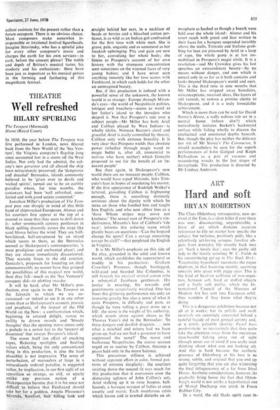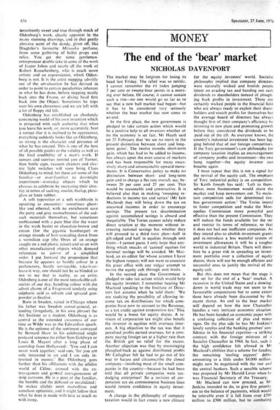ART
Hard and soft
BRYAN ROBERTSON
The Claes Oldenburg retrospective, now ar- rived at the Tate, is a silent killer if ever there was one: disconcerting, unpredictable, a form of art which disdains accurate references to life no matter how specific the subject, but reclaims, positively pulls, like a relentlessly art-loving octupus. familiar ob- jects from everyday life smartly back into art. 'Such a lovely day', says the gushy old lady to the irately scowling W. C. Fields in his unconvincing get-up in The Bank Dick: 'Fascinating hypothesis' ruminates the rogue elephant, in that booming rumble, squinting uneasily into space with piggy eyes. This is the kind of head-on collision of non-sequi- turs, between soft, hard or stuffed objects and a fairly soft public, which the In- ternational Council of the Museum of Modern Art has sent into European orbit. One wonders if they know what they're doing.
This is a dangerous exhibition because not all of it works; but its pitfalls and swift reversals are cunningly concealed behind a tasteful façade of most genteel artistry and, at a pinch, palpable identity. Pastel hues predominate: so reassuringly that they quite take the attention away from the numerous time-bomb l- ticking away out of sight (though never out of mind if you really start thinking about what you are looking at). And this is hard because the aesthetic presence of Oldenburg at his best is so strong, subtle, and original that you end up quite forgetting that you are also witnessing the final deliquescence of a far from Ideal Home. Aesthetic considerations, however, do gradually bring home the fact that Olden- burg's world is not unlike a hypothetical one of Marcel Duchamp run amok in Foam Rubber City.
In a word, the old Dada spirit runs in-
termittently sweet and true through much of Oldenburg's work, dearly apparent in the many stunning drawings, and in that gently abrasive scent of the dandy, given off, like Diaghilev's favourite Mitsouko perfume, from some gathering of ballet props and relics. You get the same gentleman- entrepreneur double-take in some of the work of Jasper Johns and nearly all the work of Robert Rauschenberg, who is much more artistic and an expressionist, which Olden- burg is not. It is the artist stepping adroitly out of the art-situation he has devised in order to point to certain pecularities inherent in what he has done, before stepping neatly back into the Frame, or diving head first back into the Object. Sometimes he trips over his own cleverness and we are left with a lot of floppy old felt.
Oldenberg has established an absolutely convincing world of his own invention which is projected with such authority that when you leave his work, or. more accurately, beat a retreat (for it is inclined to be oppressive), everything suddenly looks like an Oldenberg, so strong is the character and presence of what he has created. This is one of the best of all possible guides to the validity as well as the final credibility of a man's work. If sunsets and sunrises remind you of Turner, then bottle caps, vacuum cleaners and elec- tric light switches will soon bring Claes Oldenburg to mind, for these are some of the familiar—or over-familiar to downright impertinent—everyday objects which he chooses to celebrate by recreating their iden- 'thy in terms of sacking, muslin, burlap, plexi- glass or latex rubber.
A soft typewriter or a soft washbasin is upsetting to encounter: sometimes ghost- like and ethereal, with no enrichment save the putty and grey monochromes of the sad- sack materials themselves, but sometimes emblazoned with a pure blue (for the water in the wash basin) or chocolate-brown and cream (for the gigantic hamburger) or orange strands of hair cascading down from a vermilion cap (the fibres of an orange caught on a red plastic juicer) and so on with other manufactured objects which demand references to coloitr of a simplified order. I put forward the proposition that because he appears to handle colour in a perfunctory, barely serviceable, take-it-or- leave-it way, one should not be so blinded as not to see that in reality, as an artist, Oldenberg is one of the most remarkable col- ourists of our day, handling colour with the adroit charm of a Fragonard tenderly using sulphuric acid as solvent and sprayed gun- powder as fixative.
Born in Sweden, raised in Chicago where his father was Swedish consul-general, at- tending (irregularly, in his own phrase) the Art Institute as a student, Oldenburg is as central to the extended awareness of our time as Wilde was to the Edwardian epoch. He is the epitome of the sentiment conveyed by Bernard Shaw in his celebrated single postcard sentence (to either Sam Goldwyn or Louis B. Mayer) after a long phase of courtship from Hollywood : 'You and I can never work together,' said Gas, 'for you are only interested in art and I am only in- terested in money.' But Oldenburg goes further than his affiliations with the nihilist world of Celine. crossed with the ex- travagances and gertbral outrageousness of strip cartoons. He is a poet of the familiar, the humble and the debased or invalidated: he makes cliches seem marvellous and somehow optimistic, and it might follow that what he does is made with love as much as with irony.































 Previous page
Previous page